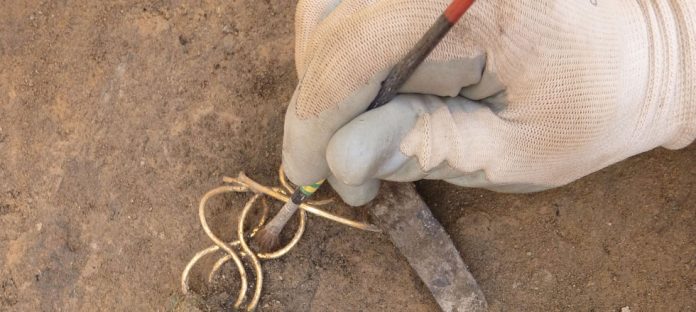Buried for safety
The jewellery had seemingly been buried for safekeeping in a small pit dug in the floor of a house during the early stages of the Boudican Revolt in AD 61.
The Roman writers Tacitus and Dio Cassius record that Colchester was largely undefended and before the Romans had withdrawn the women, children and elderly to safety the combined forces of the Iceni and Trinovantes tribes, under the leadership of Boudica, over-ran the town forcing soldiers and settled veterans to seek refuge within the walls of the unfinished temple of Claudius.
The survivors held out for two days in desperate hope of a rescue, but this did not come. Petilius Cerealis, the commander of the 9th Legion, was ordered to take part of his legion consisting of 2000 legionaries and 500 cavalry to Colchester. However, this force was ambushed by Britons as it marched to relieve the colony. By the time they approached the town it had already fallen and every man woman and child had been put to the sword. The part legion was attacked by the full force of the victorious British tribes and annihilated except the cavalry that escaped to a nearby fort.
We are told in Dio’s account that the ‘noblest’ of the Roman women were taken to the sacred groves, to their Goddess Andate, where they were sacrificed, though one cannot discount propaganda regarding the ‘savage barbarian’. The quality of the jewellery found at Williams & Griffin suggests that the owner would have been in this category, though her fate is unknown, other than she never returned for her precious items.
Background to discovery
The discovery was made during an archaeological excavation by the Colchester Archaeological Trust on the site of the Williams & Griffin department store which is currently undergoing a major programme of redevelopment. The new works have been designed to minimise the disturbance of the archaeological remains under the store. Where this proved unavoidable, the owner of the store – Fenwick Ltd – employed the Trust to excavate these areas in advance to ensure that significant archaeological remains were recorded and recovered.
Colchester is famous for its remarkable archaeology, but this treasure is a really special discovery – it represents the first Roman hoard of precious metals ever found in Colchester town centre.
Fenwick Treasure
The collection is one of the finest of its type to have been discovered in Britain, consisting of three gold armlets, a silver chain necklace, two silver bracelets, a substantial silver armlet, a small bag of coins, and a small jewellery box containing two sets of gold earrings and four gold finger-rings.
The jewellery was retained in a solid block of soil, so that it could be micro excavated and carefully recorded under controlled conditions off-site. The items are still to be fully excavated, but the conservation process will undoubtedly reveal more artefacts. The finds have been transferred to a secure conservation laboratory where a conservator and an archaeologist will complete the investigation of the finds, and then clean and stabilise the finds as well as attempt to protect the surviving traces of delicate organic remains such as leather and wood, from the jewellery box.
This significant find is already being dubbed the Fenwick Treasure in honour of the store owner who has been funding the excavation.
Other treasures
Ingredients for meals that were never eaten also lay burnt black on the floor of the room in which the jewellery was found. These include dates, figs, wheat, peas, and grain. (Others will almost certainly be identified when soil samples are examined by a specialist in ancient seeds and plant remains.)
Foodstuffs like these would not, generally, have survived, but here they had been carbonised by the heat of the fire so that their shapes were preserved perfectly. Some of the food had been stored on a wooden shelf which collapsed during the revolt, and the carbonised remains lay on the floor. The dates appeared to have been kept on the shelf in a square wooden bowl or platter.
Excavation at the Williams & Griffin store has now finished. Much analysis of the finds and results remains to be done, so this is an early provisional interpretation.
Future of the find
Fenwick plan to give the jewellery hoard to Colchester and Ipswich Museum Service and although this is classed as treasure it will not be valued by the British Museum. Thanks are due to Fenwick, for this act of generosity to the people of Colchester and the town’s fine collection of Roman antiquities.
Source: Colchester Archaeological Trust
More Information |
|
Cite this articleColchester Archaeological Trust. Colchester’s hidden Roman treasure. Past Horizons. September 6, 2014, from http://www.pasthorizonspr.com/index.php/archives/09/2014/colchesters-hidden-roman-treasure |
|





